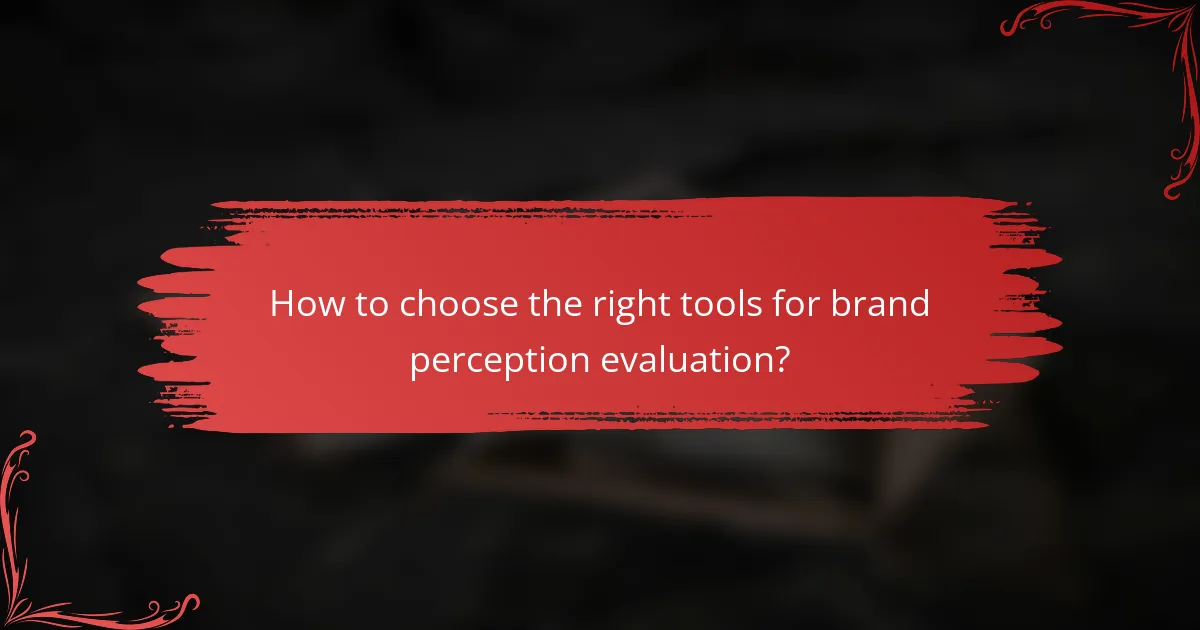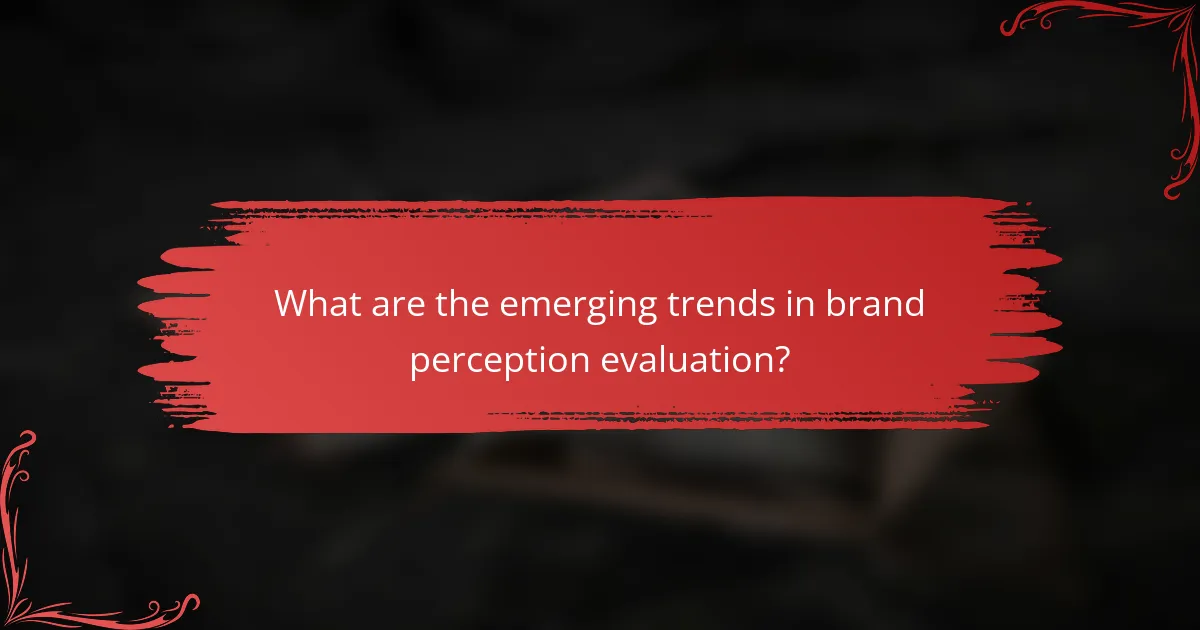Brand perception evaluation is crucial for understanding how consumers perceive and engage with a brand. By employing a mix of qualitative and quantitative methods, businesses can gain valuable insights into customer attitudes and behaviors, ultimately shaping their market strategy. Various tools, such as survey platforms and social media analytics, enhance this evaluation, while techniques like sentiment analysis and customer journey mapping further refine the understanding of brand positioning and consumer experience.

How to evaluate brand perception effectively?
Evaluating brand perception involves understanding how consumers view and interact with a brand. Effective methods include qualitative and quantitative approaches that provide insights into consumer attitudes and behaviors.
Surveys and questionnaires
Surveys and questionnaires are popular tools for gathering quantitative data on brand perception. They can be distributed online or in-person and typically include a mix of multiple-choice and open-ended questions to capture a range of consumer opinions.
When designing surveys, focus on clarity and brevity to encourage participation. Aim for a sample size that reflects your target audience, generally in the low hundreds for meaningful results. Consider incentivizing responses to increase engagement.
Focus groups
Focus groups provide qualitative insights into brand perception by facilitating discussions among a small group of participants. These sessions allow for in-depth exploration of consumer attitudes and can reveal nuances that surveys might miss.
To conduct effective focus groups, select diverse participants who represent your target market. A skilled moderator is crucial for guiding the conversation and ensuring all voices are heard. Sessions typically last one to two hours and should be recorded for analysis.
Social media analysis
Social media analysis involves monitoring and evaluating brand mentions across platforms like Twitter, Facebook, and Instagram. This method helps gauge public sentiment and identify trends related to brand perception in real-time.
Utilize social media listening tools to track keywords and hashtags associated with your brand. Analyze engagement metrics such as likes, shares, and comments to assess consumer sentiment. Regularly review this data to adapt your marketing strategies accordingly.
Brand sentiment analysis
Brand sentiment analysis uses natural language processing and machine learning to evaluate consumer emotions expressed in online content. This technique helps quantify positive, negative, or neutral sentiments towards a brand.
Implement sentiment analysis tools to scan reviews, social media posts, and other user-generated content. Look for patterns over time to understand shifts in brand perception. Be cautious of relying solely on automated tools; human interpretation can enhance accuracy and context.

What tools can assist in brand perception evaluation?
Several tools can effectively assist in evaluating brand perception, providing insights into customer opinions and behaviors. These tools range from survey platforms to social media analytics, each offering unique features that help brands understand their standing in the market.
Qualtrics for surveys
Qualtrics is a powerful survey tool that allows brands to gather detailed feedback from customers regarding their perceptions. It offers customizable survey templates and advanced analytics to interpret the data effectively.
When using Qualtrics, consider targeting specific demographics to ensure the feedback is relevant. Aim for a sample size that reflects your customer base, typically in the hundreds for meaningful insights.
Brandwatch for social listening
Brandwatch specializes in social listening, enabling brands to monitor online conversations about their products and services. This tool analyzes social media platforms, blogs, and forums to capture real-time sentiment and trends.
Utilize Brandwatch to identify key themes in customer discussions and track brand mentions over time. This can help in understanding public perception and adjusting marketing strategies accordingly.
Google Analytics for web insights
Google Analytics provides valuable insights into how users interact with your website, which can reflect brand perception. By analyzing metrics such as bounce rate, session duration, and user demographics, brands can gauge how effectively they communicate their value proposition.
To maximize Google Analytics, set up goals to track conversions that matter to your brand, such as newsletter sign-ups or product purchases. Regularly review these metrics to identify trends and areas for improvement.
Hootsuite for social media management
Hootsuite is a comprehensive social media management tool that allows brands to schedule posts, track engagement, and analyze performance across various platforms. It helps in maintaining a consistent brand voice while monitoring audience reactions.
When using Hootsuite, take advantage of its analytics features to assess which types of content resonate most with your audience. Regularly adjust your strategy based on these insights to enhance brand perception and engagement.

What techniques enhance brand perception analysis?
Techniques that enhance brand perception analysis include sentiment analysis algorithms, competitor benchmarking, and customer journey mapping. These methods provide insights into consumer attitudes, market positioning, and the overall experience customers have with a brand.
Sentiment analysis algorithms
Sentiment analysis algorithms evaluate consumer opinions expressed in text, such as social media posts, reviews, and surveys. By using natural language processing (NLP), these algorithms categorize sentiments as positive, negative, or neutral, helping brands gauge public perception.
When implementing sentiment analysis, consider the context and cultural nuances of language. For example, sarcasm or regional slang can skew results. Regularly updating your algorithms to reflect changing language trends is crucial for accuracy.
Competitor benchmarking
Competitor benchmarking involves comparing your brand’s performance against key competitors to identify strengths and weaknesses. This technique helps brands understand their market position and discover areas for improvement.
To conduct effective benchmarking, gather data on competitors’ customer satisfaction scores, social media engagement, and product offerings. Tools like SWOT analysis can help visualize these comparisons. Aim to benchmark against at least three competitors for a comprehensive view.
Customer journey mapping
Customer journey mapping visualizes the steps a consumer takes from awareness to purchase and beyond. This technique highlights touchpoints where customers interact with the brand, revealing opportunities to enhance their experience.
When creating a customer journey map, gather qualitative data through interviews and quantitative data from analytics tools. Identify key emotions and pain points at each stage to inform strategies for improvement. Regularly update the map to reflect changes in customer behavior and preferences.

What cultural insights impact brand perception?
Cultural insights significantly shape brand perception by influencing how consumers interpret and relate to brands. Understanding these insights helps businesses tailor their marketing strategies to resonate with diverse audiences.
Regional consumer behavior
Regional consumer behavior varies widely based on local customs, traditions, and economic conditions. For instance, consumers in Southern Europe may prioritize family-oriented marketing, while those in Northern Europe might value sustainability and innovation. Brands must adapt their messaging and product offerings to align with these regional preferences.
To effectively engage with consumers, companies should conduct market research that includes surveys and focus groups specific to each region. This approach helps identify unique consumer needs and preferences, allowing brands to craft localized marketing strategies.
Cultural values and beliefs
Cultural values and beliefs play a crucial role in shaping consumer attitudes toward brands. For example, in collectivist cultures, brands that emphasize community and social responsibility often fare better than those focused solely on individualism. Understanding these cultural dimensions can guide brands in positioning themselves appropriately.
Brands should consider integrating local values into their branding efforts. This might include partnerships with local charities or campaigns that highlight cultural heritage, which can enhance brand loyalty and trust among consumers.
Trends in consumer preferences
Trends in consumer preferences are influenced by cultural shifts, technological advancements, and global events. For instance, the rise of digital consumption has led to increased demand for brands that offer seamless online experiences. Staying attuned to these trends allows brands to remain relevant and competitive.
Monitoring social media, industry reports, and consumer feedback can provide valuable insights into emerging preferences. Brands should be agile, ready to pivot their strategies based on these insights to meet changing consumer expectations effectively.

How to choose the right tools for brand perception evaluation?
Selecting the right tools for brand perception evaluation involves understanding your specific needs and the capabilities of available options. Focus on features, ease of use, and budget to ensure you choose a tool that effectively captures consumer insights.
Assessing tool features
When evaluating tools for brand perception, consider essential features such as survey capabilities, analytics, and reporting functions. Look for tools that offer customizable surveys to gather targeted feedback and robust analytics to interpret the data effectively.
Additionally, check for integration options with existing systems, such as CRM or marketing platforms, to streamline data collection and analysis. A tool that supports multiple data sources can provide a more comprehensive view of brand perception.
Evaluating user-friendliness
User-friendliness is crucial when selecting a brand perception evaluation tool. A straightforward interface allows team members to navigate the tool easily, reducing the learning curve and enhancing productivity. Look for tools that offer tutorials or customer support to assist users.
Consider conducting a trial or demo to assess the user experience firsthand. Tools that provide intuitive dashboards and clear visualizations can help stakeholders quickly grasp insights without extensive training.
Considering budget constraints
Budget constraints play a significant role in choosing brand perception evaluation tools. Determine your budget range and explore options that fit within it while still meeting your essential requirements. Many tools offer tiered pricing based on features, so assess which features are necessary for your evaluation.
Be cautious of hidden costs, such as fees for additional users or premium features. It’s often beneficial to compare a few tools side by side to identify the best value for your investment, ensuring you get the most relevant features for your budget.

What are the emerging trends in brand perception evaluation?
Emerging trends in brand perception evaluation focus on leveraging technology and cultural insights to understand consumer sentiment more effectively. Tools such as AI-driven analytics and social media monitoring are becoming essential for brands to gauge public opinion and adapt their strategies accordingly.
AI and Machine Learning in Brand Perception
AI and machine learning are transforming brand perception evaluation by analyzing vast amounts of data quickly and accurately. These technologies can identify patterns in consumer behavior, sentiment, and preferences, allowing brands to respond proactively to shifts in perception.
For instance, brands can use sentiment analysis tools to monitor social media conversations in real-time, enabling them to address negative feedback promptly. This approach not only enhances brand reputation but also fosters customer loyalty.
Cultural Insights and Local Adaptation
Understanding cultural nuances is crucial for effective brand perception evaluation. Brands must adapt their messaging and strategies to resonate with diverse consumer bases across different regions. This involves researching local customs, values, and preferences to ensure relevance.
For example, a global brand may tailor its advertising campaigns to reflect local holidays or cultural events, which can significantly enhance consumer connection. Brands that successfully incorporate cultural insights often see improved engagement and brand loyalty.
Real-time Feedback Mechanisms
Real-time feedback mechanisms are becoming increasingly popular for evaluating brand perception. Tools like online surveys, social media polls, and instant feedback widgets allow brands to gather consumer opinions immediately after interactions.
Implementing these mechanisms can help brands identify issues quickly and make necessary adjustments. For example, a restaurant chain might use real-time feedback to assess customer satisfaction after a dining experience, enabling them to enhance service and food quality on the spot.
Integration of Multi-channel Data
Integrating data from multiple channels is essential for a comprehensive view of brand perception. Brands should consider insights from social media, customer reviews, sales data, and website analytics to form a holistic understanding of how they are perceived.
By analyzing data across these channels, brands can identify trends and correlations that may not be apparent when looking at a single source. For instance, a spike in negative reviews on a product might correlate with a specific marketing campaign, prompting a reevaluation of messaging strategies.
